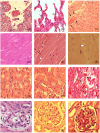Insights into pathophysiology and therapeutic strategies for heat stroke: Lessons from a baboon model
- PMID: 38124439
- PMCID: PMC10988686
- DOI: 10.1113/EP091586
Insights into pathophysiology and therapeutic strategies for heat stroke: Lessons from a baboon model
Abstract
Heat stroke is a perilous condition marked by severe hyperthermia and extensive multiorgan dysfunction, posing a considerable risk of mortality if not promptly identified and treated. Furthermore, the complex biological mechanisms underlying heat stroke-induced tissue and cell damage across organ systems remain incompletely understood. This knowledge gap has hindered the advancement of effective preventive and therapeutic strategies against this condition. In this narrative review, we synthesize key insights gained over a decade using a translational baboon model of heat stroke. By replicating heat stroke pathology in a non-human primate species that closely resembles humans, we have unveiled novel insights into the pathways of organ injury and cell death elicited by this condition. Here, we contextualize and integrate the lessons learned concerning heat stroke pathophysiology and recovery, areas that are inherently challenging to investigate directly in human subjects. We suggest novel research directions to advance the understanding of the complex mechanisms underlying cell death and organ injury. This may lead to precise therapeutic strategies that benefit individuals suffering from this debilitating condition.
Keywords: cell death; coagulation abnormalities; heat stress response; hyperthermia; inflammatory response; organ injury.
© 2023 The Authors. Experimental Physiology published by John Wiley & Sons Ltd on behalf of The Physiological Society.
Conflict of interest statement
The authors declare that they have no competing interests.
Figures










References
-
- Abildgaard, C. F. , Harrison, J. , & Johnson, C. A. (1971). Comparative study of blood coagulation in nonhuman primates. Journal of Applied Physiology, 30(3), 400–405. - PubMed
-
- al‐Mashhadani, S. A. , Gader, A. G. , al Harthi, S. S. , Kangav, D. , Shaheen, F. A. , & Bogus, F. (1994). The coagulopathy of heat stroke: Alterations in coagulation and fibrinolysis in heat stroke patients during the pilgrimage (Haj) to Makkah. Blood Coagulation & Fibrinolysis, 5(5), 731–736. - PubMed
-
- Argaud, L. , Ferry, T. , Le, Q. H. , Marfisi, A. , Ciorba, D. , Achache, P. , Ducluzeau, R. , & Robert, D. (2007). Short‐ and long‐term outcomes of heatstroke following the 2003 heat wave in Lyon, France. Archives of Internal Medicine, 167(20), 2177–2183. - PubMed
-
- Austin, M. , & Berry, J. (1956). Observations on one hundred cases of heatstroke. The Journal of the American Medical Association, 161(16), 1525–1529. - PubMed
-
- Bazille, C. , Megarbane, B. , Bensimhon, D. , Lavergne‐Slove, A. , Baglin, A. C. , Loirat, P. , Woimant, F. , Mikol, J. , & Gray, F. (2005). Brain damage after heat stroke. Journal of Neuropathology & Experimental Neurology, 64(11), 970–975. - PubMed
Publication types
MeSH terms
LinkOut - more resources
Full Text Sources
Other Literature Sources
Miscellaneous
